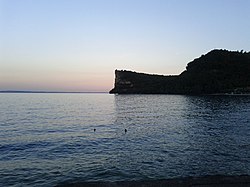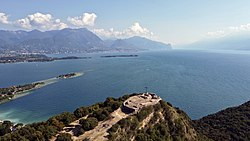- Olive trees around the Rocca di Manerba del Garda
- View of the municipality of Manerba del Garda from the peak of Rocca di Manerba del Garda
- View of the natural reserve of 900,000 square meters from the peak of Rocca di Manerba del Garda
- View of Lake Garda from the north of Rocca di Manerba del Garda
- View of the sunrise from Rocca di Manerba del Garda
- Christian cross at the peak of Rocca di Manerba del Garda
- View of the Rocca di Manerba del Garda and the Island of Rabbits
- View of Rocca di Manerba del Garda and Monte Pizzocolo from the municipality of Manerba del Garda
| Rocca di Manerba del Garda (Lombardy) | |
|---|---|
 Christian cross at the peak of Rocca di Manerba del Garda | |
Location in Lombardy | |
| General information | |
| Type | Fortress |
| Architectural style | Medieval architecture |
| Location | Lombardy |
| Address | Via Giacomo Matteotti, 10, 25080 Manerba del Garda BS |
| Town or city | Manerba del Garda |
| Country | Italy |
| Coordinates | 45°33′45.5575″N10°33′10.5722″E / 45.562654861°N 10.552936722°E |
| Elevation | 190 m (620 ft) |
| Technical details | |
| Material | Bricks, stones, granite, iron, ceramic, marble, wood |
| Size | 84 hectares (210 acres) |
| Website | |
| www | |
The Rocca di Manerba del Garda (fortress of Manerba del Garda) is a rocky promontory, that extends along the southwestern coast of Lake Garda, in Lombardy, Italy. The site, named after its medieval fortification period, is archaeologically significant, with human occupation evidenced from the Mesolithic, Neolithic, Bronze Age, Iron Age, ancient Roman and Medieval periods. [1] Archaeological features include the ruins of the medieval fortification on the summit, and, on the south-western side of the peninsula, the remains of an ancient Roman villa. It consists of two main peaks: the Rocca Vecchia and the hill with the hermitage of San Giorgio. [2]
Contents
- Location
- History
- Prehistoric period
- Historic period
- Geology
- Archaeological features
- Civic Archaeological Valtenesi Museum
- Flora and fauna
- Flora
- Fauna
- Mountain bike and running trails
- Curiosities
- The legend of the Rocca di Manerba del Garda
- Sacredness and rites
- Books
- Similar fortifications
- See also
- Gallery
- References
- External links















